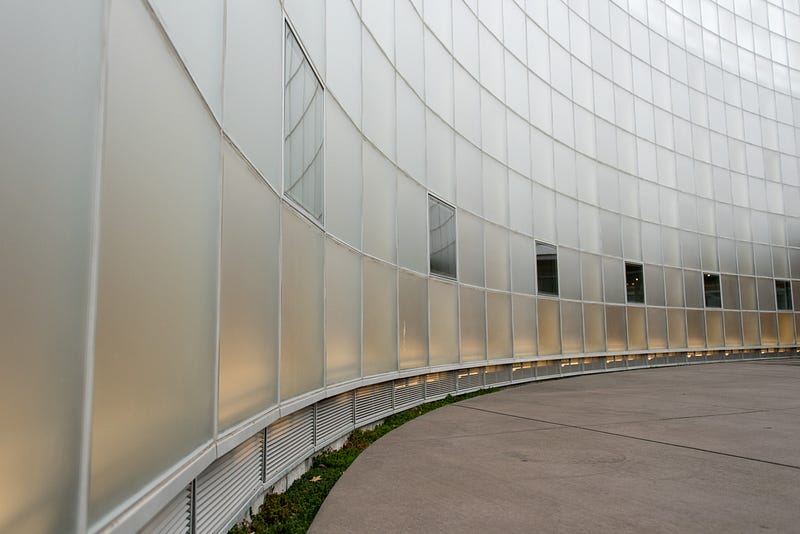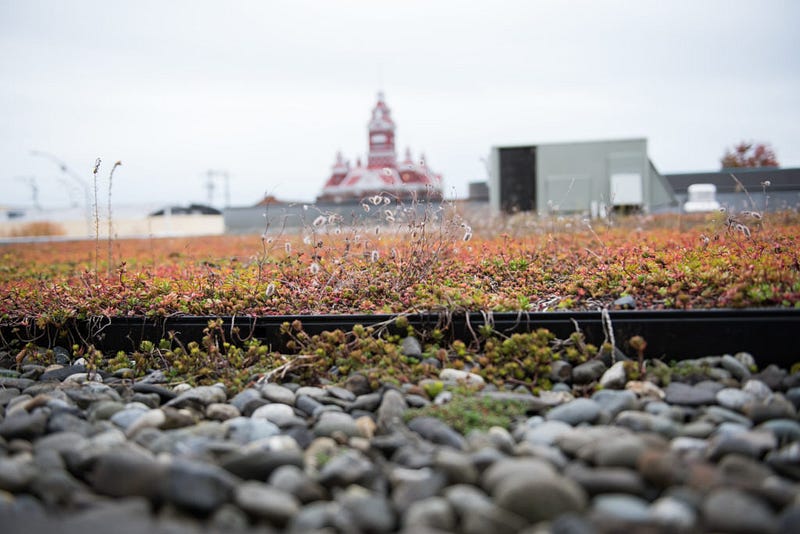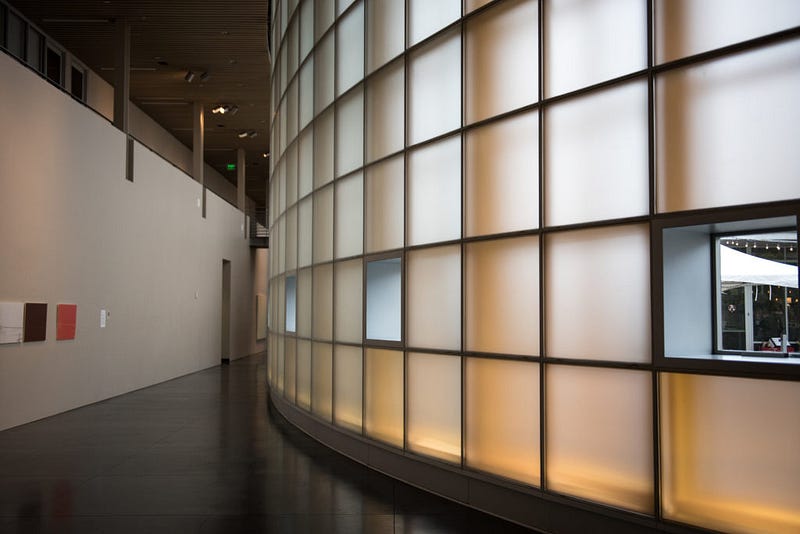LEED

The Lightcatcher’s green design inspires a sustainable future.
Written by Shannon Finn // Photos by Daisey James
On a rare sunny day in the Pacific Northwest, sunlight reflects through a 180-foot translucent, tiled window, producing soft light within an art gallery.
The Lightcatcher isn’t an ordinary art museum. It was designed under a certification system to be built sustainably — the Leadership in Energy and Environmental Design, or LEED, system.
Stepping inside, visitors see the natural light and open windows — the building’s sustainable features.
The Lightcatcher Building houses the main gallery space for the Whatcom Museum located in Bellingham, Washington. Opened seven years ago, the Lightcatcher was the first museum in Washington state to receive a LEED Silver certification.
The United States Green Building Council awards LEED certifications based on water, energy and atmosphere, materials and resources, indoor environmental quality, sustainable sites and other factors within a building. Similar to sports where an athlete can win a medal for their achievements, buildings can achieve a rating of certified, silver, gold or platinum, earning extra credit for innovative design or geographical-specific environmental conditions.
Christina Claassen, marketing and public relations manager at the Whatcom Museum, thinks most visitors aren’t aware the Lightcatcher is LEED certified.
“I think they definitely get a sense that it’s using some elements of the environment to make it a little more sustainable,” she says.
Building certification
In 2009, Whatcom County voted for all new building projects to be built to the LEED Silver standard or higher.
Buildings consume roughly 40 percent of all energy produced in the United States and account for nearly 40 percent of carbon emissions, according to the U.S. Energy Information Administration.
On average, LEED certified buildings have 34 percent lower carbon emissions, consume a quarter less energy, and have redirected more than 80 million tons of waste from landfills, according to the U.S. Department of Energy.



Light wall
During a sunlit or an overcast gray day, the radiant 37-foot wall, the Lightcatcher’s most well-known feature, casts a passive soft solar glow, lighting the inside of the building and hallway. At night, interior lights reflect off this wall and allow the museum to illuminate downtown. The way light plays off the wall means less electricity is needed to illuminate the building.
The Lightcatcher’s windows regulate the temperature inside. During the summer months, the windows open, but only a crack. During the wintertime, the windows remain closed.
Optimizing air quality and daylight creates a healthy space for visitors.
Seasonal affective disorder, or SAD, is a type of depression that changes with the seasons and is common among those who live in the Pacific Northwest. Reduced sunlight can lead to a drop in serotonin, a brain chemical that regulates mood, causing depression symptoms.
The disorder is seven times more common in Washington state than in Florida, according to Achieve Solutions.
Jim Olson, the owner of Olson Kundig architectural firm, designed the Lightcatcher Building to highlight the Northwest’s most sacred resource: sunlight.
In the Pacific Northwest, mist and fog are common appearances. With the soft look of the windows, Olson wanted to recreate the mystery of mist and fog by not being able to see through it clearly.
Ventilation and flooding
Her upper vents, not visible to the public, also regulate the insulation and temperature, as the vents open and close regularly. When showcasing art, keeping bugs and critters out and preventing dramatically fluctuating temperatures is key.
Under the tall, looming light wall, visitors sit at tables in an open courtyard called the Garden of Ancients, a lush space with past and present native plants. To prevent flooding, the courtyard’s pavement absorbs rainwater by allowing the water to travel through the pavement to the rocks and soils below the surface. This recharges the local groundwater resources.
The United States Environmental Protection Agency reports that retrofitting one out of every 100 homes in the United States with efficient water features could prevent around 80,000 tons of greenhouse gas releases, which is equal to the removal of 15,000 cars from the road for a single year.
Using rainwater catchment tanks, or what look like huge farm silos, the Lightcatcher reuses rainwater for the toilets in all the bathrooms.
Water is a precious resource, especially in drought-plagued areas. Green building practices can provide some relief on water demand. Buildings use nearly 14 percent of all filtered water, or 15 trillion gallons per year, but green buildings are anticipated to reduce water usage by 15 percent and save more than 10 percent in running costs, according to a study conducted in 2000 by the United States Geological Survey.
Sustainable wood
Amidst paintings of Washington’s landscapes on smooth wood, small hands and excited eyes play with shapes, color and light in the Family Interactive Gallery where parents and children explore, play and learn in a wood-lined space. The wood is a sustainably harvested material, and is meant to resemble the kind that washes up on Washington’s shores.
“The colors of the exterior and galleries reflect the bark of our trees and the rocks on our beaches. The ceilings reference weathered driftwood, and silver metal details reflect the Northwest’s ‘oyster light,’” Olson says.
Natural materials and resources fulfill LEED certification, and adding a familiar and local space to those who visit.
Rain gardens & living roof
The Lightcatcher features rain gardens that filter pollutants as water soaks through the ground, helping sustain local groundwater. They provide habitats for the local birds and bugs and minimize flooding and erosion in streams.
Up above the courtyard area sits a Green Roof with red, yellow and green plants interspersed with several vents. The goal of this green, vegetated roof is to absorb rainwater and decrease runoff and flooding, as well as increase insulation, which decreases heating and cooling costs. Providing a Green Roof and rain gardens allows an urban area to access naturally lowered temperatures and filtered air.
Green buildings are cost-effective, use natural resources in efficient ways, lower utility bills and reduce the negative environmental impact. The United States Green Building Council reports that “green retrofit projects are generally expected to pay for themselves in just seven years.”
Global warming is rapidly accelerating, demanding humans take action in their communities. As melting glaciers, rising tides and record-high temperatures increase in frequency, green buildings present a prevention tactic. The Lightcatcher is one such structure, helping pave the way for the future of sustainable buildings.
